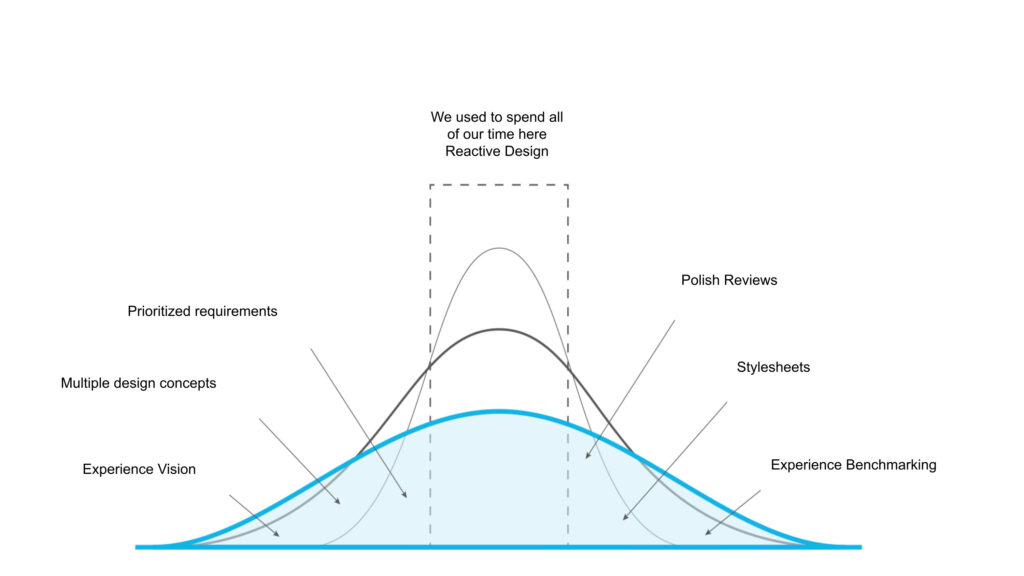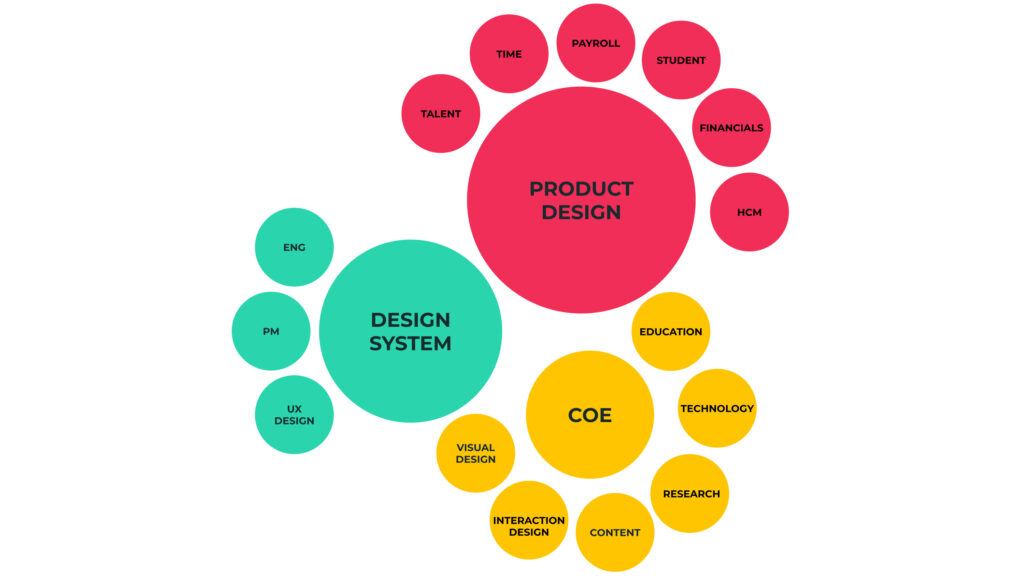Shifting and scaling design strategy
This example is pulled from 2019. It highlights a key moment in the Workday Design org’s growth and maturity, where we took a significant step forward. I set strategic direction for the organization to broaden our definition of what a design team delivers, and established a team of seasoned leaders to grow our ability to solve some of the harder, organizational problems we were encountering.
The problem
As Workday Design grew quickly, and as we were a less mature design organization, there was a tendency for our partners to expect that what we did was deliver comps. Research was not taken as seriously as we would like, we did not have enough time to do great work (or at least it was our perception that we did not have enough time), we focused on the look more than the flow and the problems to solve.
Content strategy was just a seed of an idea. Process, strategy, operations, these were all things we had not dedicated enough time to. We were at an inflection point. We knew we needed to get better to meet the growing demands on us as Workday continued to grow. And we were not only growing in size, but also locations globally, and supporting more and more complex products. At the time, I read somewhere that organizations should revisit how they communicate every time they double in size.
It was time to take a look at how we worked, what we worked on, and how we could make product at Workday in a more design-focused way. Two key actions I took was to set some changing expectations with the design org through strategic direction, and to create a team of principal level contributors that we called the design center of excellence within our org – this team was the beginnings of our design operations functions.
Design Organization Strategy
As we headed into the start of a new year in 2019, I was looking to broaden the definition of design at Workday. I wanted to get us out of a rut I was seeing, and hearing from our teams and partners, on a growing perception that we were not having the impact we were expecting. And I wanted to signal to the design org that it was okay to do things differently, and provide a perspective on how. I was seeing us be timid to try new things, and do the things we knew we should do. I introduced three focus areas for us as an organization, and I talked about these as the products we produce as an org:
- we deliver great experiences
- we create a shared understanding
- we deliver knowledge about our users
All three could be done independently, with its own value, but when all three are working together across an organization, that’s when the great work happens.
Moving out of the middle
I had earlier developed an engagement model for our design leaders and teams to leverage as we assign and approach our work. It’s quite simple, yet effective, and has 4 levels: full, medium, consulting, and no support.
FULL
full engagement of design, research, content and facilitation across the full product cycle
MEDIUM
mid-level coverage with some design and/or research support at points in time during the product cycle
CONSULTING
consulting guidance and advice on understanding our users and using our design patterns
NO SUPPORT
design system playbook
It was important to me to call out that no support is a decision that can be made. And as we were developing our design system to contain a playbook for product teams and customers to leverage, we had tools for teams to use without us.
As we were looking to deliver more impact as an organization, I did an assessment on where we were spending our time, and much of our projects were at the medium engagement level. An implication of this was that much of our work was in the middle of a design life-cycle, often starting after requirements were defined, and with too little involvement polishing the release and assessing it once live.

We weren’t committing enough to the projects where we should be all in, and we were overcommitting on some that could use a lighter support. I wanted to move us upstream and downstream more. Getting out of the middle stuck as a way for our design leaders to approach their team’s work. And the phrase is sticky, and drives our thinking today.
Scaling design strategy, outreach and education
I had set a path for broadening our definition of design, I had armed our leaders with a perspective on how to better leverage our engagement model, and how to approach project allocations differently, and now I wanted to dedicate more time as an org on strategic items, on the hard problems that the we faced.
I proposed that we establish a team of senior level practitioners from each of the disciplines from within design to dedicate time and energy on solving these hard problems. I pitched the charter as being a focus on strategy, outreach and education. We assembled a team of these leader practitioners with each individual representing a different focus area of design: research, interaction design, creative direction and visual design, design technology, content design and design education.

We kicked off the forming of this team with dedicated time for coming together and setting a charter. I kicked off our time together by putting a stake in the ground on what we could achieve:
- Design infused
- We create a design culture that Workday is known for
- We have values that represent us
- We are proud of our products
- We do good for users, period
- People want to come work for Workday Design
- Product teams want to work with Workday Design
- We set a vision for our products
- We imagine the future
And I asked the group to consider three key perspectives as they start out on there journey together.
One is to consider Workday as they make decisions. To consider Workday’s values, and to reflect on them as they work. And to consider the teams and the people in the design organization and who we work with. My intent was to challenge this group to seek to understand who is here, what strengths can others bring to this work, how can we HARNESS the organization’s great work and amplify it. I wanted them to really be in tune with what was going on in the organization.
Two is to not be afraid to change your mind on something. I was asking this group to have hard conversations about how we work, operate, and how we approach solving problems. Each of these leaders brought different perspectives, and they didn’t all see things the same way. They all had different ideas on how to approach things, this is good. We should embrace this. We should get better at this. The ideas that emerge from this group should be different than the ones that go in – the ideas should change, get tweaked, morphed into better ideas. And I said including everything I’m saying now!
Three is to not be afraid to think big. To be a little edgy. To be different and push boundaries. To reach beyond where we think we can get to. To find a way to move forward on the really hard things, to change culture, to build a great design organization when we have far to go, and to work on things we don’t know how to work on.
The outcome
The center of excellence group went on to accomplish some really great things, including incubating and launching the content design discipline at Workday, establishing research operations, bringing product creative direction in alignment with brand and marketing, kicking off longitudinal and generative research to really up our level of understanding our users, building alignment with product leaders on the need for and the path to creating product experience visions, and more.
The design org increased its time spent on deliverables like vision concepts that are now included in product strategy discussions, we established a formal polish stage for designer/engineers to work together to polish a release before it goes out the door, and the designs org’s capacity planning now assesses how we approach our work across our engagement levels, ensuring our teams are set up to be successful.